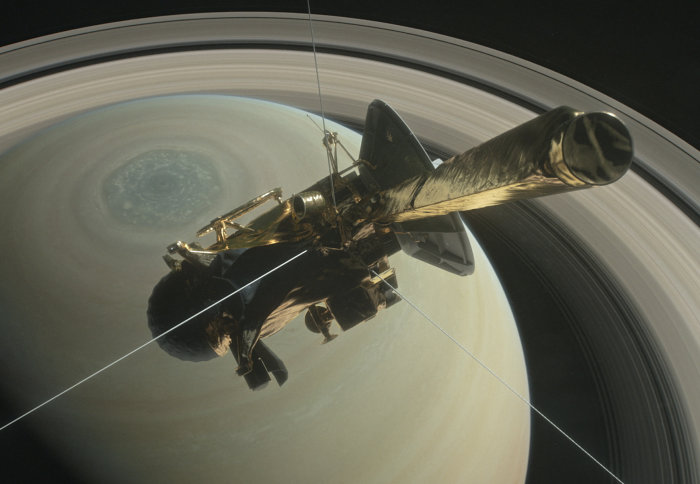Latest insights into Saturn’s weird magnetic field only make things weirder

Credit: NASA/JPL-Caltech
Some of the last data from the Cassini mission reveals more structure in Saturn’s magnetic field, but still no answer as to how it formed.
NASA’s Cassini mission – with Imperial kit on board – took a series of daring dives between the planet and its inmost ring in September 2017 before burning up in the planet’s atmosphere.
A first analysis of the data from the magnetometer instrument, built and run by Imperial College London physicists, shows that the planet's magnetic field has a tilt of less than 0.01º. The results are published today in a special issue of Science reporting the first end-of-mission results.
It looks increasingly likely we will have to rethink the ways different kinds of planets can form magnetic fields. Professor Michele Dougherty
It was thought that magnetic fields around planets can only form when there is a discernible tilt between the rotation axis of the planet and the magnetic field axis. This is the situation on Earth, where the magnetic poles are offset from the geographic poles.
This tilt sustains currents in a liquid metal layer deep inside a planet – on Earth this is a liquid iron-nickel layer around the solid iron core, and on Saturn it’s believed to be a metallic hydrogen layer surrounding a small rocky core.
The more accurately we measure, the smaller it gets
Principal investigator for the magnetometer Professor Michele Dougherty, from the Department of Physics at Imperial, said: “Each time we more accurately measure the tilt of Saturn’s magnetic field, it gets smaller, until now we are in a position where it is smaller than a hundredth of a degree. This is in sharp contrast to the Earth’s magnetic field tilt of 11 degrees.
“It may still be that Saturn’s turbulent atmosphere of thick gases is obscuring some of the magnetic data, but it looks increasingly likely we will have to rethink the ways different kinds of planets can form magnetic fields.”
While the almost negligible tilt is a surprising mystery to scientists, the team did spot some other interesting structures in the magnetic field close to the planet, which may hold further clues.
Closer to Saturn, they saw signals that hint at a secondary source of magnetism for the planet. Above the deep liquid hydrogen layer creating the main planet-wide magnetic field, they suggest there is a shallower layer producing many much smaller, stable magnetic fields.
Tantalising signatures of other fields at play
There also seems to be an electric current flowing between the inner ring, the D ring, and the planet. The rings cut across the main magnetic field lines as they lie around the planet’s equator, and may play a role in shaping magnetic fields generated externally from the planet.
Study co-author Dr Gregory Hunt, from the Department of Physics at Imperial, said: “There are tantalising signatures of other fields at play in the magnetic environment of Saturn, potentially influenced by the rings or by the wind patterns in the atmosphere.
“Despite Cassini’s mission ending a year ago, we will be digging through the data and making new discoveries for years to come.”
The team are looking closer at these phenomena and modelling possible structures for the interior of Saturn. They will also be combining their data with that of other instruments on Cassini. For example, combining the magnetometer data with gravity data could allow them to work out the mass, size and density of the planet’s core.
-
‘Saturn’s magnetic field revealed by the Cassini Grand Finale' by Michele K. Dougherty, Hao Cao, Krishan K. Khurana, Gregory J. Hunt, Gabrielle Provan, Stephen Kellock, Marcia E. Burton, Thomas A. Burk, Emma J. Bunce, Stanley W. H. Cowley, Margaret G. Kivelson, Christopher T. Russell, and David J. Southwood is published in Science.
Article supporters
Article text (excluding photos or graphics) © Imperial College London.
Photos and graphics subject to third party copyright used with permission or © Imperial College London.
Reporter
Hayley Dunning
Communications Division